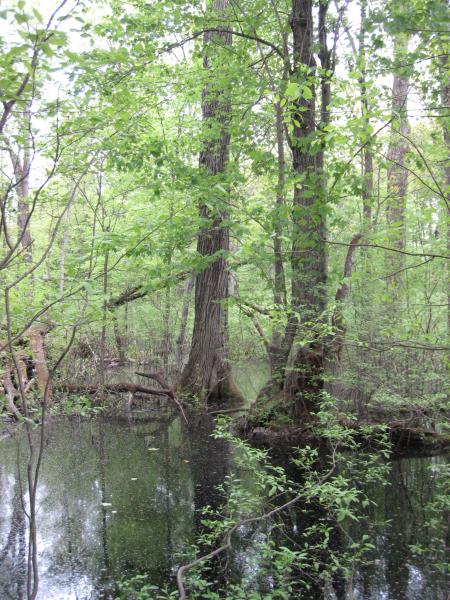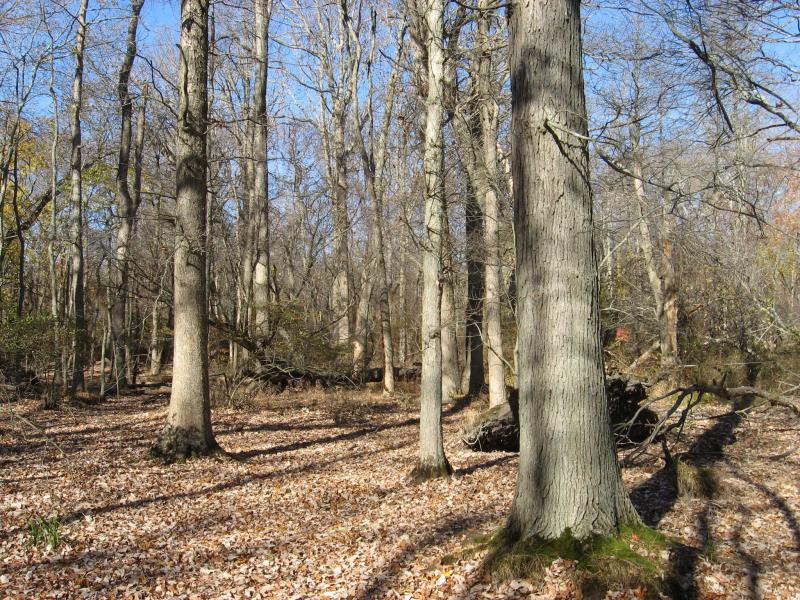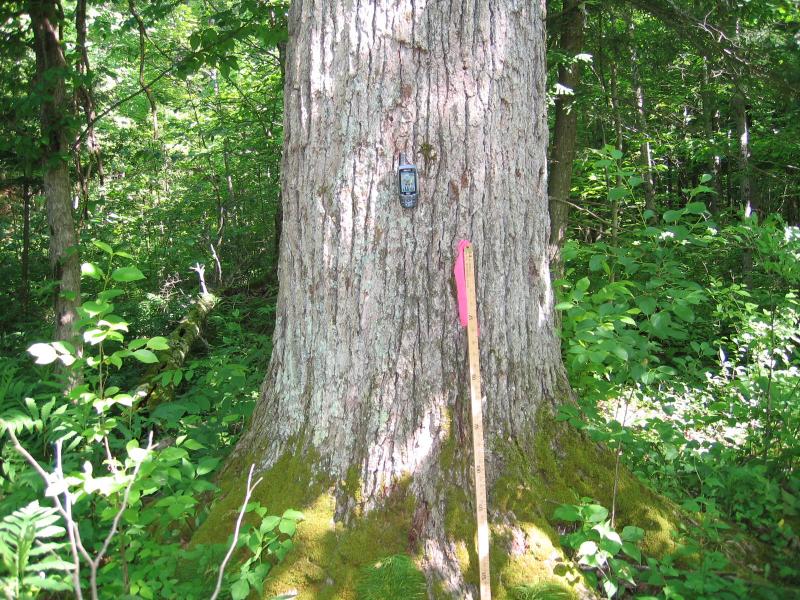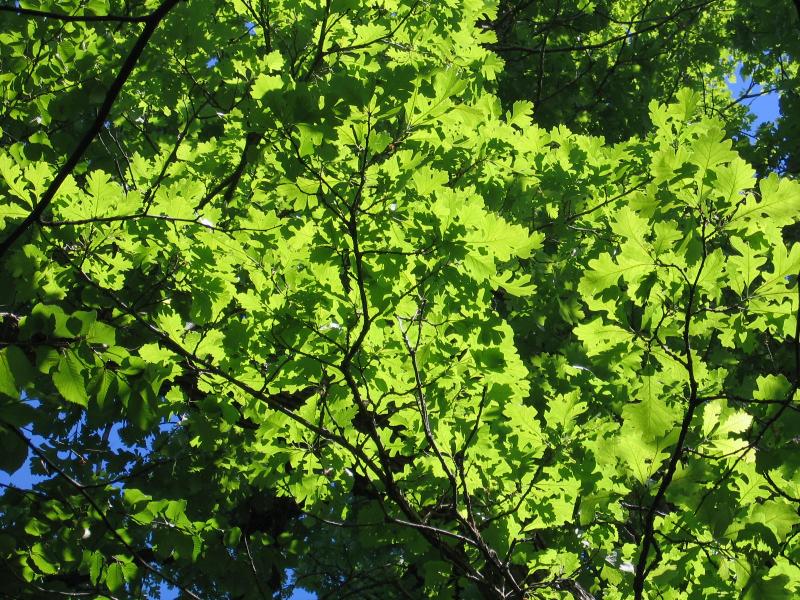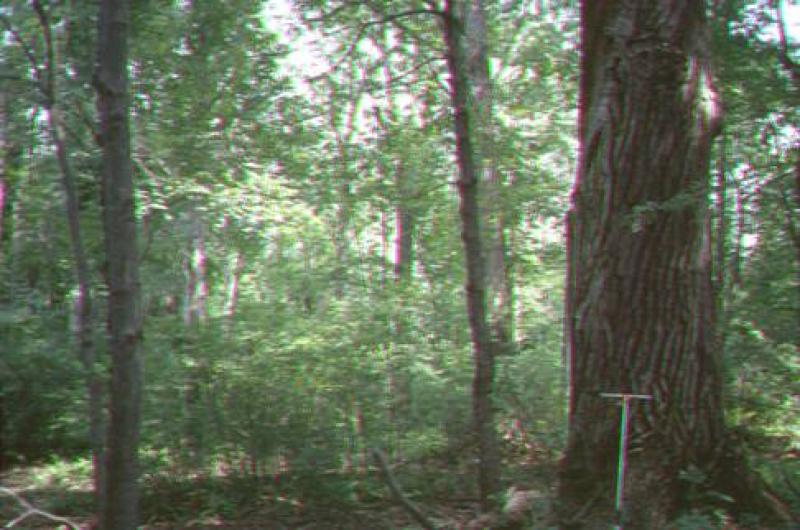Red Maple-Swamp White Oak Swamp
- System
- Palustrine
- Subsystem
- Forested Mineral Soil Wetlands
- State Protection
- Not Listed
Not listed or protected by New York State.
- Federal Protection
- Not Listed
- State Conservation Status Rank
- S2
Imperiled in New York - Very vulnerable to disappearing from New York due to rarity or other factors; typically 6 to 20 populations or locations in New York, very few individuals, very restricted range, few remaining acres (or miles of stream), and/or steep declines.
- Global Conservation Status Rank
- G3G4
Vulnerable globally, or Apparently Secure - At moderate risk of extinction, with relatively few populations or locations in the world, few individuals, and/or restricted range; or uncommon but not rare globally; may be rare in some parts of its range; possibly some cause for long-term concern due to declines or other factors. More information is needed to assign either G3 or G4.
Summary
Did you know?
If at first glance you see a tree with leaves and bark that looks like white oak (Quercus alba) in a swamp with red maple, then look closer to see if it is swamp white oak (Quercus bicolor). Swamp white oak leaves are hairy on the lower surface, whereas white oak lacks hair on the underside of the leaves.
State Ranking Justification
There are an estimated 20 to 30 extant occurrences statewide. Very few documented occurrences have good viability and few are protected on public land or private conservation land. This community has a somewhat limited statewide distribution that is primarily concentrated on the coastal plain where there are a few small, good quality examples. The current trend of this community is probably stable for occurrences on public land and private conservation land, or declining slightly elsewhere due to moderate threats that include alteration of the natural hydrology and introduction of invasive species.
Short-term Trends
The number and acreage of red maple-swamp white oak swamps in New York have probably declined slightly, or remained stable, in recent decades as a result of wetland protection regulations. Since World War II, urbanization has emerged as the predominant force impacting wetlands in most parts of the region (Golet et al. 1993).
Long-term Trends
The number and acreage of red maple-swamp white oak swamps in New York have probably declined substantially from historical numbers likely correlated with agricultural and other development. The principal causes of wetland loss in the Northeast prior to mid-1800s include conversion of wetlands to agriculture, the construction of impoundments for hydropower and water supply, and the cutting of swamp timber for lumber, fence posts, and fuel wood (Golet et al. 1993).
Conservation and Management
Threats
Red maple-swamp white oak swamps are threatened by development in the surrounding landscape and its assocaited run-off (e.g., residential and commercial development, roads, bridges, utility ROWs, etc.), habitat alteration (e.g., excessive logging, filling, pollution), and recreational overuse (e.g., hiking, ATVs, trash dumping). Alteration to the natural hydrological regime is also a threat to this community (e.g., impoundments, blocked culverts, lowering water table). Deer over-browsing may be a threat at a few sites. Several red maple-swamp white oak swamps are threatened by invasive species, such as reedgrass (Phragmites australis ssp. australis ) and multiflora rose (Rosa multiflora). Conversion of wetlands for agriculture was a major cause of inland wetland loss in many areas of the Northeast historically, and it is still an important factor today, most notably in New York (Golet et al. 1993). In 2001, the federal Supreme Court ruled that the US Congress did not give authority to the US Army Corps of Engineers (US ACE) under section 404 of the Clean Water Act to regulate the filling of isolated wetlands. This decision led US EPA and US ACE officials to issue guidance in January 2003 that made it more difficult for regulators to protect isolated wetlands, such as perched swamp white oak swamps (Comer et al. 2005).
Conservation Strategies and Management Practices
Where practical, establish and maintain a natural wetland buffer to reduce storm-water, pollution, and nutrient run-off, while simultaneously capturing sediments before they reach the wetland. Buffer width should take into account the erodibility of the surrounding soils, slope steepness, and current land use. Wetlands protected under Article 24 are known as New York State "regulated" wetlands. The regulated area includes the wetlands themselves, as well as a protective buffer or "adjacent area" extending 100 feet landward of the wetland boundary (NYS DEC 1995). If possible, minimize the number and size of impervious surfaces in the surrounding landscape. Avoid habitat alteration within the wetland and surrounding landscape. For example, roads and trails should be routed around wetlands, and ideally should not pass through the buffer area. If the wetland must be crossed, then bridges and boardwalks are preferred over filling. Restore swamps that have been affected by unnatural disturbance (e.g., remove obsolete impoundments and ditches in order to restore the natural hydrology). Prevent the spread of invasive exotic species into the wetland through appropriate direct management, and by minimizing potential dispersal corridors, such as roads.
Development and Mitigation Considerations
When considering road construction and other development activities, minimize actions that will change what water carries and how water travels to this community, both on the surface and underground. Water traveling over-the-ground as run-off usually carries an abundance of silt, clay, and other particulates during (and often after) a construction project. While still suspended in the water, these particulates make it difficult for aquatic animals to find food; after settling to the bottom of the wetland, these particulates bury small plants and animals and alter the natural functions of the community in many other ways. Thus, road construction and development activities near this community type should strive to minimize particulate-laden run-off into this community. Water traveling on the ground or seeping through the ground also carries dissolved minerals and chemicals. Road salt, for example, is becoming an increasing problem both to natural communities and as a contaminant in household wells. Fertilizers, detergents, and other chemicals that increase the nutrient levels in wetlands cause algae blooms and eventually an oxygen-depleted environment where few animals can live. Herbicides and pesticides often travel far from where they are applied and have lasting effects on the quality of the natural community. So, road construction and other development activities should strive to consider: 1. how water moves through the ground, 2. the types of dissolved substances these development activities may release, and 3. how to minimize the potential for these dissolved substances to reach this natural community.
Inventory Needs
Survey for occurrences statewide to advance documentation and classification of red maple-swamp white oak swamp.
Research Needs
Research is needed to fill information gaps about red maple-swamp white oak swamps, especially to advance our understanding of their classification, ecological processes, hydrology, floristic variation, and characteristic fauna. A statewide survey of swamp white oak dominated or co-dominated swamps is desirable. Occurrences in New York should be critically compared to perched swamp white oak swamps, clayplain forests in Vermont (Thompson and Sorenson 2000), and other more common forested mineral soil wetlands (e.g., red maple-hardwood swamp, silver maple-ash swamp, and floodplain forest).
Rare Species
Range
New York State Distribution
Red maple-swamp white oak swamps are currently known from the coastal plain inland to Saratoga Springs, NY on sandy soil. It is very likely that there are more undocumented occurrence between the currently known limits. It is less likely that this community occurs in northern NY (e.g., Adirondacks) and central NY (e.g., Finger Lakes Region).
Global Distribution
This vegetation occurs in southern New England south to Maryland and northern Virginia, but occurreces similar to NY on sandy soil underlain by a clay layer are presumed to be more limited in distribution.
Best Places to See
- North Fork Preserve (Suffolk County)
- Saratogoga Spa State Park (Suffolk County)
- Arshamomaque Pond Preserve (Suffolk County)
Identification Comments
General Description
This hardwood swamp is typically found in small, isolated basins on sandy soils that are underlain by a clay layer. The swamp floods seasonally and draws down in most years exposing a leaf litter substrate. The swamp is codominated by red maple (Acer rubrum) and oaks, such as swamp white oak (Quercus bicolor) and/or pin oak (Q. palustris). Characteristic shrubs include winterberry (Ilex verticillata), highbush blueberry (Vaccinium corymbosum), buttonbush (Cephalanthus occidentalis), and arrowwood (Viburnum dentatum). Herb cover is typically sparse. Characteristic herbs include various sedges (Carex spp.), such as C. crinita, C. grayi, C. lupulina, and C. tuckermanii. Other characteristic herbs include ferns, such as cinnamon fern (Osmunda cinnamomea), royal fern (Osmunda regalis), marsh fern (Thelypteris palustris), and netted chain fern (Woodwardia areolata).
Characters Most Useful for Identification
The swamp is on sandy soils that are underlain by a clay layer. It is codominated by red maple (Acer rubrum) and oaks, such as swamp white oak (Quercus bicolor) and/or pin oak (Q. palustris). The swamp floods seasonally and draws down in most years exposing a leaf litter substrate.
Elevation Range
Known examples of this community have been found at elevations between 5 feet and 290 feet.
Best Time to See
Late fall and winter are a good time to walk through red maple-swamp white oak swamps, because the water usually has drawn down exposing the firm substrate blanketed with leaf litter.
Red Maple-Swamp White Oak Swamp Images
Classification
International Vegetation Classification Associations
This New York natural community encompasses all or part of the concept of the following International Vegetation Classification (IVC) natural community associations. These are often described at finer resolution than New York's natural communities. The IVC is developed and maintained by NatureServe.
- Pin Oak - (Swamp White Oak ) - Red Maple / Highbush Blueberry / Cinnamon Fern Wet Forest (CEGL006240)
NatureServe Ecological Systems
This New York natural community falls into the following ecological system(s). Ecological systems are often described at a coarser resolution than New York's natural communities and tend to represent clusters of associations found in similar environments. The ecological systems project is developed and maintained by NatureServe.
- North-Central Interior Wet Flatwoods (CES202.700)
- Northern Atlantic Coastal Plain Basin Swamp and Wet Hardwood Forest (CES203.520)
Characteristic Species
-
Trees > 5m
- Acer rubrum var. rubrum (common red maple)
- Carya glabra (pignut hickory)
- Fagus grandifolia (American beech)
- Fraxinus pennsylvanica (green ash)
- Nyssa sylvatica (black-gum, sour-gum)
- Quercus bicolor (swamp white oak)
- Ulmus americana (American elm)
- Ulmus rubra (slippery elm)
-
Shrubs 2 - 5m
- Acer rubrum var. rubrum (common red maple)
- Fraxinus nigra (black ash)
- Fraxinus pennsylvanica (green ash)
- Ilex verticillata (common winterberry)
- Quercus alba (white oak)
- Quercus bicolor (swamp white oak)
- Ulmus rubra (slippery elm)
- Vaccinium corymbosum (highbush blueberry)
- Viburnum dentatum var. lucidum (smooth arrowwood)
-
Shrubs < 2m
- Fagus grandifolia (American beech)
- Ilex verticillata (common winterberry)
- Quercus bicolor (swamp white oak)
- Viburnum dentatum var. lucidum (smooth arrowwood)
-
Tree saplings
- Acer rubrum var. rubrum (common red maple)
- Amelanchier arborea (downy shadbush)
-
Vines
- Toxicodendron radicans ssp. radicans (eastern poison-ivy)
-
Lianas
- Smilax rotundifolia (common greenbrier)
- Toxicodendron radicans ssp. radicans (eastern poison-ivy)
- Vitis riparia (river grape, frost grape)
-
Short vines
- Smilax rotundifolia (common greenbrier)
-
Herbs
- Carex bromoides ssp. bromoides (brome-like sedge)
- Carex grayi (Gray's sedge)
- Carex gynandra (nodding sedge)
- Carex sp.
- Carex tuckermanii (Tuckerman's sedge)
- Cinna arundinacea (stout wood-reed)
- Dryopteris carthusiana (spinulose wood fern)
- Juncus effusus ssp. solutus (common soft rush)
- Ludwigia palustris (water-purslane)
- Moehringia lateriflora (blunt-leaved-sandwort)
- Onoclea sensibilis (sensitive fern)
- Osmunda regalis var. spectabilis (royal fern)
- Osmundastrum cinnamomeum var. cinnamomeum (cinnamon fern)
- Solidago rugosa var. rugosa (common wrinkle-leaved goldenrod)
- Thelypteris palustris var. pubescens (marsh fern)
-
Nonvascular plants
- Sphagnum sp.
Similar Ecological Communities
- Perched swamp white oak swamp
(guide)
While both communities may be co-dominated by red maple and swamp white oak, and draw down in most years; perched swamp white oak swamps are located on hilltops, or on steps in slopes, over bedrock; whereas red maple-swamp white oak swamps occur on sandy soil underlain by clay.
- Red maple-blackgum swamp
(guide)
Red maple-swamp white oak swamps may have some blackgum, but it is not codominant. Red maple-blackgum swamps are usually permanently saturated compared to red maple-swamp white oak swamps that draw down in most years.
- Red maple-hardwood swamp
(guide)
Red maple-hardwood swamps may have some swamp white oak, but it is not codominant. Red maple-hardwood swamps are usually permanently saturated compared to red maple-swamp white oak swamps that draw down in most years.
Vegetation
Percent cover
This figure helps visualize the structure and "look" or "feel" of a typical Red Maple-Swamp White Oak Swamp. Each bar represents the amount of "coverage" for all the species growing at that height. Because layers overlap (shrubs may grow under trees, for example), the shaded regions can add up to more than 100%.
Additional Resources
References
Edinger, G. J., D. J. Evans, S. Gebauer, T. G. Howard, D. M. Hunt, and A. M. Olivero (editors). 2014. Ecological Communities of New York State. Second Edition. A revised and expanded edition of Carol Reschke’s Ecological Communities of New York State. New York Natural Heritage Program, New York State Department of Environmental Conservation, Albany, NY. https://www.nynhp.org/ecological-communities/
Edinger, Gregory J., D.J. Evans, Shane Gebauer, Timothy G. Howard, David M. Hunt, and Adele M. Olivero (editors). 2002. Ecological Communities of New York State. Second Edition. A revised and expanded edition of Carol Reschke's Ecological Communities of New York State. (Draft for review). New York Natural Heritage Program, New York State Department of Environmental Conservation. Albany, NY. 136 pp.
NatureServe. 2015. NatureServe Explorer: An online encyclopedia of life [web application]. Version 7.1. NatureServe, Arlington, Virginia. Available http://www.natureserve.org/explorer.
New York Natural Heritage Program. 2024. New York Natural Heritage Program Databases. Albany, NY.
New York Natural Heritage Program. No date. Field forms database: Electronic field data storage and access for New York Heritage ecology, botany, and zoology. New York Natural Heritage Program, New York State Department of Environmental Conservation. Albany, NY.
Reschke, Carol. 1990. Ecological communities of New York State. New York Natural Heritage Program, New York State Department of Environmental Conservation. Latham, NY. 96 pp. plus xi.
Links
About This Guide
This guide was authored by: Gregory J. Edinger
Information for this guide was last updated on: May 16, 2024
Please cite this page as:
New York Natural Heritage Program. 2024.
Online Conservation Guide for
Red maple-swamp white oak swamp.
Available from: https://guides.nynhp.org/red-maple-swamp-white-oak-swamp/.
Accessed July 27, 2024.

